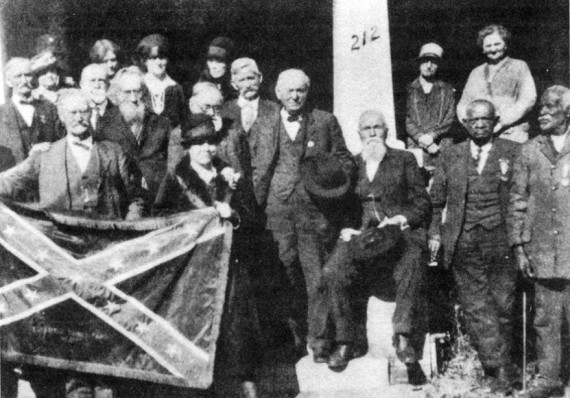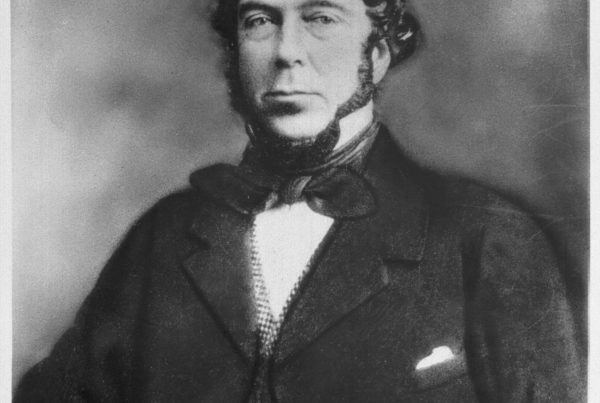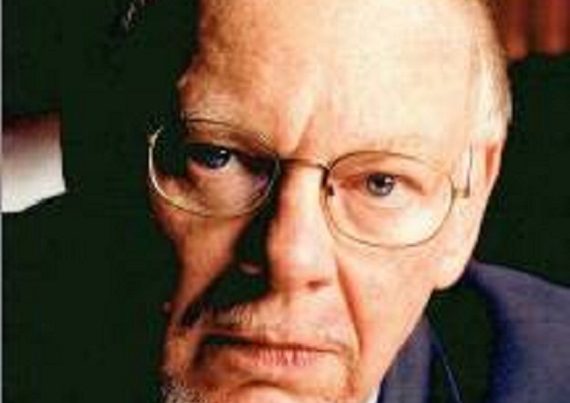A review of Black Confederates and Afro-Yankees in Civil War Virginia, by Ervin L. Jordan, Jr., Charlottesville: University Press of Virginia, 1995, 447 pages; and Black Slaveowners: Free Black Slavemasters in South Carolina, 1790-1860, by Larry Koger, Columbia: University of South Carolina Press, 1994, 286 pages.
Black Confederates! Remember, you heard it here first. You will be hearing more if you have any interest at all in the Great Unpleasantness of the last century that is the focal point of American history. There are more things in heaven and earth, dear Horatio, than are dreamed of by Ken Burns.
In the film Gettysburg appears the English Colonel Arthur Fremantle, played as a somewhat silly character. Fremantle was a real person who accompanied the Confederate Army on the Gettysburg campaign and published a book, Three Months in the Southern States. One incident noted by Fremantle in his book did not, of course, make it into the movie—the spectacle of a black Confederate marching Yankee prisoners to the rear.
Real life is always a lot more complicated than ideological history. The image that most Americans carry around in their heads of the Old South and the black slavery that flourished over much of this continent for two and a half centuries is cartoonish and largely misleading. (Just think of Uncle Tom’s Cabin and Roots.) It is also, of course, extremely comforting to the mainstream American consciousness to think of the heroic soldiers in blue marching forth to strike the chains from the suffering black people —setting aside the fact that emancipation did not become a war goal until well after hostilities had begun, and that in many eases it resulted only in destructive uprooting or a change of masters.
The material brought forth in these two recently published works has not been unknown; it has always been self-evident to serious historians who have worked with primary sources. Large numbers of black people identified the South and the Confederacy as their homeland and homefolks, and did not rush into the arms of the emancipators. This really is not surprising to anyone who knows anything about history or human nature, which, of course, does not include Ken Burns. The Confederate Army was vastly sustained by black men who drove teams, cooked, foraged, dug fortifications, cared for the wounded, and occasionally took up arms. George Washington Cable, the author, when a mere youth of 15 or so, served as General Bedford Forrest’s headquarters clerk. At the beginning of the War, Forrest took 50 of his slaves with him, promising freedom if they served faithfully. Cable records how he was told by Forrest to make out emancipation papers for all but one of these. A number of units of free blacks volunteered for Confederate service, and near the end of the War the Confederacy had decided to enlist black units. There was much opposition to this invasion of private property, but there was also solid support. Unlike the Union Army, they were to receive the same pay as white soldiers. It is a fact that black men who had been with the army were welcomed at Confederate reunions and received Confederate pensions from Southern states.
Dr. Jordan’s book presents a tremendous amount of documentation about the activities of black Virginians for and against the Confederacy. He is far from a Confederate sympathizer, which makes the data all the more telling. When one considers that over large areas of the South, the black population was 70 to 90 percent and most able-bodied white men were off fighting the War, and that nevertheless no uprisings or significant outrages occurred on the homefront, one has to take a rather more complicated view of the Civil War than is usually passed around. It is true that many slaves left when they had the chance, when federal forces came near, but sometimes they had to be taken away by force. (Often they found themselves pressed into harsher service with the Union Army than with the Southern.) This attitude of the blacks was not due to ignorance or lack of understanding. When Sherman burned over 100 blocks of Columbia, the “winds” that were said to have been responsible did not spare the homes of black people, though they did, mysteriously, jump over that of the French consul. The mayor of Columbia observed three Union soldiers shoot to death a black man they considered insolent. When he reported this to Sherman he was told, “We don’t have time for court martials and such.” During Sherman’s progress blacks, like white civilians, were left without food and shelter, and black women were much more vulnerable than white women were to rape and murder. Jordan’s book is not the only one in this field of revisionism. The Journal of Confederate History a few years ago published as an entire issue a symposium on “Black Southerners in Gray”; while Professor Edward C. Smith of American University, an African-American, has produced two video tape lectures on the same subject.
Prior to the War there were almost a half-million free blacks in the United States, more than half of whom lived in the South. Historians have long noted that many of these were prosperous, and some were slaveowners. The situation has usually been explained as one of a few blacks having nominal ownership of relatives. There was some of that, but also abundant evidence, as marshaled by Koger for South Carolina (and for Louisiana by Gary Mills, Forgotten People: Cane River’s Creoles of Color, 1977) that many participated in the Southern economy as masters of slave labor in exactly the same way as their white neighbors. (At the time of the averted Denmark Vesey insurrection in Charleston in the 1820s, 72 percent of free black households in the city held slaves.) All of this is not to provide a defense of slavery, but it does provide the grounds for a less simplistic and moralistic rendering of our ambivalent history.
In the 1970s, it was fashionable to attribute American racial problems to “the legacy of slavery.” Is it not curious that, the further away we have moved in time and location from the regime of the Old South, the worse these problems have become? How simple it was, in the days before the Watts riots, to attribute all problems to the benighted South. If only the South were corrected with an iron hand, then all would be well. That was a false and destructive rationale, as should be evident to all. It is said that there is now a net in-migration of black Americans back to the South, reversing the pattern of most of this century. There is also evidence that the South (except for a few international metropolises like Atlanta, New Orleans, and Dallas) enjoys more racial peace and progress than elsewhere in the Union.
It appears that Americans are in the process of rethinking some of the fundamentals of race relations that have been held sacrosanct for the past half century. These historical works are both a product of and a contribution to that rethinking, which yet has far to go.
First-hand evidence abundantly demonstrates that black men were present in great numbers with Confederate armies at all times. A great deal of the cooking, wagon driving, tending wounded, and camp work was done by these men. Many Southerners remarked with gratitude after the War of the support of such people. Of course, some took off, but many others did not, despite many opportunities to do so. President Davis when in the army camps greeted and shook hands with the black men as well as the white. Despite the efforts of some historians to trump up stories of fierce resistance by and fierce put-downs of slaves, it is obvious that there was never any hint of slave insurrection, or the South could not have fought so long and so effectively. The women and children were perfectly safe at home from that possibility.
Kent Masterson Brown, a distinguished lawyer from Kentucky who is also well known as a Civil War historian, has recently completed a book on the Confederate retreat from Gettysburg. He found that when the survivors came back from the Pickett-Pettigrew charge, they returned to Confederate lines that were lined with black faces. Some 6,000 to 10,000 black men went with the army to Pennsylvania—and back. The English observer Col. Fremantle saw a black Confederate marching a Yankee prisoner to the rear. He wondered at their reaction if the abolitionists in London could see that. Brown has found that many of those black men after Gettysburg took their wounded and dead masters home, sometimes to distant places in the far South.
It is hard for current folks to accept, but relations between blacks and whites in the South were sometimes familial. In soldiers’ letters (and this is also true of ante-bellum Southerners in general) it is sometimes difficult to determine whether people mentioned are family members or servants. When you think about it, this is not at all unusual. History is full of examples of faithful retainers and servants fighting for their masters and against their masters’ enemies. It is a quite common human phenomenon. Faulkner, the great American artist of the 20th century, portrayed this situation often, along with its ambiguity and contradictions.
The interesting question, of course, is why acknowledgment of these facts is so fiercely resisted and misrepresented. There is a natural reluctance among many black people to accept that many “accepted” slavery, that all of their forebears were not in constant resistance and rebellion. But the choice for most of their people most of the time was not between slavery and freedom, but rather just making the best of the situation which life gave them. (Like most of us, most of the time.) Black and white Southerners have different histories, of course, but 1 very much believe that we should emphasize the good parts of the common history that we have shared. From my outsider’s viewpoint, it seems to me a plus for African-Americans to recognize that their history is much more complex, multi-dimensional, and interesting than a simple (and false) story of repression and rebellion.
To really understand the position of the slaves of the South in the Civil War and to explain the resistance to ideas that contradict the official story, you have to understand that for mainstream America the Civil War is a morality play in which Yankees righteously liberate the grateful oppressed. That story has tremendous emotional commitment but it is not true. Before, during, and after the Civil War, the Yankees never did anything from the primary motive of helping the black people. This is what Frederick Douglass meant when he called Lincoln “the white man’s president.” The denial of the existence of black Confederates has less to do with African-Americans than with American self-righteousness.
The American myth would have you think that the righteous soldiers in blue and the liberated slaves rushed into each other’s arms. Nothing could be further from the truth. We can understand the black Confederate better if we understand that liberation by the Yankees was not always a positive experience. Southerners owned slaves and believed in white supremacy. But as many foreign observers pointed out, they were not as militantly racist as Northerners. In general, Yankees were more interested in getting rid of black people than in freeing them. Letters of Northern soldiers who were encountering black people for the first time make the biggest collection of racist literature before Goebbels.
Remember, Lincoln’s Illinois had laws, of which Lincoln approved, for bidding black people to even settle in the state; and those who lived there hail no civil rights. The Union was fighting for power, not freedom and equality. When black soldiers were enlisted, it was because they freed that number of white men from risking their lives.
When farms — houses, food, livestock, crops —are deliberately destroyed by an invading army whose policy is to demoralize civilians, black people as well as white are left starving. Black people arc just as subject to murder, robbery and rape by invading troops as are white, probably more so. Historians have recently trumped up a good many stories of atrocities by Confederates against slaves. But that is minor and exaggerated compared to the Union armies’ well-documented atrocities against and disdain for the black people of the South. We know that many black people left the plantations and farms in the wake of Union armies. Of course, people in a devastated area naturally take to the road and go where they think they can find food. And some were fed In the Union armies at times, though Yankee generals constantly complained of the freed slaves as a nuisance. Actually, it is not clear to what degree slaves went with the Union army willingly or they were actually kidnapped and forced. And what is their fate if they do follow the liberator? To become a forced laborer of the army or a servant or concubine of a Union officer. It is not too far a stretch to recognize that many people might choose to remain with the home and people they knew, even if they were slaves.







